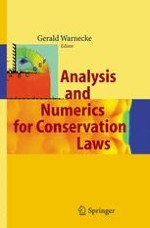2005 | OriginalPaper | Chapter
Flexible Flame Structure Modelling in a Flame Front Tracking Scheme
Authors : Heiko Schmidt, Rupert Klein
Published in: Analysis and Numerics for Conservation Laws
Publisher: Springer Berlin Heidelberg
Activate our intelligent search to find suitable subject content or patents.
Select sections of text to find matching patents with Artificial Intelligence. powered by
Select sections of text to find additional relevant content using AI-assisted search. powered by
A numerical technique for the simulation of accelerating turbulent premixed flames in large scale geometries is presented. It is based on a hybrid capturing/tracking method. It resembles a tracking scheme in that the front geometry is explicitly computed and propagated using a level set method. The basic flow properties are provided by solving the reactive Euler equations. The flame-flow-coupling is achieved by an in-cell-reconstruction technique, i.e., in cells cut by the flame the discontinuous solution is reconstructed from given cell-averages by applying Rankine-Hugoniot type jump conditions. Then the reconstructed states and again the front geometry are used to define accurate effective numerical fluxes across grid cell interfaces intersected by the front during the time step considered. Hence the scheme also resembles a capturing scheme in that only cell averages of conserved quantities are updated. To enable the modelling of inherently unsteady effects, like quenching, reignition, etc., during flame acceleration, the new key idea is to provide a local, quasi-onedimensional flame structure model and to extend the Rankine-Hugoniot conditions so as to allow for inherently unsteady flame structure evolution. A source term appearing in the modified jump conditions is computed by evaluating a suitable functional on the basis of a onedimensional flame structure module, that is attached in normal direction to the flame front. This module additionally yields quantities like the net mass burning rate, necessary for the propagation of the level set, and the specific heat release important for the energy release due to the consumption of fuel. Generally the local flame structure calculation takes into account internal (small scale) physical effects which are not active in the (large scale) outer flow but essential for the front motion and its feedback on the surrounding fluid. If a suitable set of different (turbulent) combustion models to compute the flame structure is provided, the new numerical technique allows us to consistently represent laminar deflagrations, fast turbulent deflagrations as well as detonation waves. Supplemented with suitable criteria that capture the essence of a Deflagration-to-Detonation-Transition (DDT), the complete evolution of such an event can be implemented in principle.
